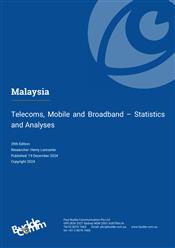Malaysia Telecoms Market Report
Telecoms, Mobile and Broadband - Statistics and Analyses

Malaysia’s mobile market sees consolidation with the merger of Digi and Celcom
As part of a diverse range of initiatives designed to move the country from developing to developed status by 2025, Malaysia has enabled and encouraged open competition in its telecommunications market. The result is very high penetration levels in both the mobile and mobile broadband segments, and near-universal coverage of LTE networks.
The incumbent telco Telekom Malaysia retains an almost monopolistic hold on the fixed-line market, as well as a significant lead in fixed broadband. However, there is growing market competition as more fibre cable networks are being deployed around the country on top of Telekom Malaysia’s national backbone. Operators such as Maxis have seen a rapid growth in the number of fibre subscribers, in part due to the migration of its existing fixed wireless broadband subscribers to the faster fibre network.
Consumers are the main beneficiaries of the highly competitive market. They enjoy widespread access to high-speed mobile services as well as attractive offers on bundles to keep data use up but prices low. The downside is that Malaysia’s MNOs and MVNOs have struggled to increase revenue in line with growth in the number of subscribers and with greater demand for broadband data. While the operators have been successful in moving a significant proportion of customers from prepaid to higher-value postpaid accounts, ARPU remains under pressure because of competitive pricing. The overcrowded mobile market saw some consolidation in 2022 when Digi and Celcom merged, creating CelcomDigi. The new entity has more than 20.3 million subscribers and will be better placed to provide cheaper services to customers through improved economies of scale.
The government elected to create a single 5G network managed by a single operator, DNB, providing wholesale access to the MNOs. All MNOs except Maxis had signed access deals by early 2023. DNB covered 50% of populated areas by the end of 2022 and expected to cover 80% by 2024.
There was some reticence among MNOs to sign access deals with DNB, given that the latter’s monopoly limited opportunities for the MNOs to differentiate their 5G services, or negotiate wholesale pricing. Following calls by the MNOs for a dual wholesale network model, the newly installed government in December 2022 announced that it would consider allowing a second 5G network to be built, with access to be made available from January 2024.
Key Developments
- ACE cable consortium members contract Ciena to increase the cable’s capacity by about 193%.
- Government considers allowing a second 5G network to be built, to compete with DNB which currently retains a monopoly on access to 5G infrastructure.
- Telecom Malaysia embarks on an internal reorganisation under which its telecom business will be transferred to a single operating unit, TM Technology.
- SEA-H2X cable system connecting to Malaysia at Kuching to be lit in 2024.
- Digi and Celcom complete merger of their Malaysian mobile operations.
- Malaysia’s 3G networks are shut down, with the spectrum reallocated to LTE use.
- Report update includes the regulator's telecom sector data to December 2022, telcos' operating and financial data to Q4 2022, updated Telecom Maturity Index charts and analyses, recent market developments.
Key companies mentioned in this report:
Telekom Malaysia, TIME dotCom, Maxis Communications, Celcom Axiata, Digi, CelcomDigi, U Mobile, Altel.
Related Reports
- Asia - Mobile Infrastructure and Mobile Broadband
- Asia - Fixed Broadband Market - Statistics and Analyses
- Asia - Mobile Network Operators and MVNOs
- Malaysia - Data Centre Market
- Indonesia - Telecoms, Mobile and Broadband - Statistics and Analyses
- Myanmar (Burma) - Telecoms, Mobile and Broadband - Statistics and Analyses
- Uzbekistan - Telecoms, Mobile and Broadband - Statistics and Analyses
- Taiwan - Telecoms, Mobile and Broadband - Statistics and Analyses
- China - Telecoms, Mobile and Broadband - Statistics and Analyses
Share this Report
TMT Intelligence
A platform to scale your intelligence tasks
Monitor critical insights with our AI-powered Market Intelligence Platform gathering and analyzing intelligence in real time. With AI trained to spot emerging trends and detect new strategic opportunities, our clients use TMT Intelligence to accelerate their growth.
If you want to know more about it, please see:
Research Methodology
BuddeComm's strategic business reports contain a combination of both primary and secondary research statistics, analyses written by our senior analysts supported by a network of experts, industry contacts and researchers from around the world as well as our own scenario forecasts.
For more details, please see:
More than 4,000 customers from 140 countries utilise BuddeComm Research
Are you interested in BuddeComm's Custom Research Service?
Hot Topics
News & Views
Have the latest telecommunications industry news delivered to your inbox by subscribing to BuddeComm's weekly newsletter.